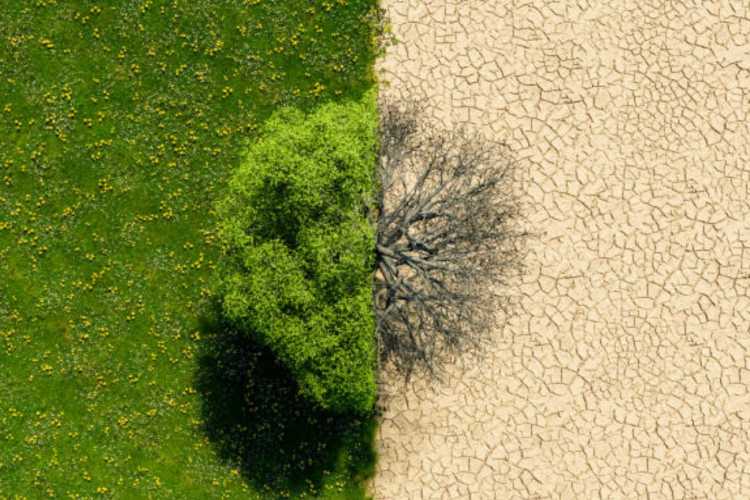
Climate change: While Gaza’s pulverised streets and Ukraine’s artillery-scarred steppes dominate the evening news, another conflict unfolds in quieter tones—between a warming planet and those who coax food from its soil. The front pages miss the relentless march of droughts across the Yangtze basin, the salt tides creeping into the Sundarbans, and the dust storms that now chase herders from the Sahel to the Mediterranean. Each calamity strips away a layer of rural resilience, converting once-fertile districts into departure lounges for families who have run out of harvests, credit and hope.
Evidence of the upheaval is no longer anecdotal. The World Meteorological Organisation counted 603 extreme-weather events in 2024 alone—nearly double the annual average of the previous decade—with 148 classified as unprecedented and 289 as unusual. Those incidents killed 1,700 people and displaced 824,000, a figure that exceeds the entire wartime exodus from Bosnia in the 1990s. Floods in southern Brazil, megafires in Canada, and heat domes over South Asia now share a common signature: they turn farmers into fugitives, driving internal migration first to provincial towns and then, inexorably, across borders ill-prepared for the slower refugee crisis of climate change.
READ | Fake fertilisers threaten crop yields, food security
Harvests in the line of fire
In China’s Yangtze basin, the subtropical high normally due in mid-July arrived two weeks early this year, pushing temperatures past 40 °C and desiccating paddy fields just as panicle initiation began. Power demand hit an all-time high as farmers wrestled with failing irrigation pumps.

Thousands of kilometres away, north-western Europe is enduring the driest spring in a century. Dutch and German farmers, already scarred by 2018’s drought, now face rainfall deficits of 50 per cent; agronomists warn of crop losses that could reach 30 per cent if June rains falter.
Drought is now the single largest climatic peril for Europe’s food basket, driving average losses of €28 billion a year—6 per cent of total output—and projected to breach €40 billion by 2050. Fewer than one in three euros of that damage is insured.
From failed crops to footloose populations
Agricultural distress rarely stays within farm boundaries. When wells run dry and yields collapse, families sell livestock, withdraw children from school and finally abandon their land. The WMO’s 2024 numbers confirm a sharp rise in weather-driven displacement, the majority linked to crop or pasture failure.
Nowhere is the chain clearer than in coastal Bangladesh. A one-metre rise in sea level would submerge 18 per cent of the delta’s arable land; by 2050, an estimated 13.3 million Bangladeshis could become internal climate migrants, many flowing into the already teeming cities of India’s east.
Similar fault-lines are opening in the Sahel, Central America’s Dry Corridor and Brazil’s northeast, where alternating floods and droughts have displaced millions and seeded new routes for irregular migration. Each failed harvest adds pressure to urban labour markets and stokes political volatility far from the original disaster zone.
The invisible refugee
Yet the law lags behind the science. The 1951 Refugee Convention recognises persecution, not precipitation; its silence leaves climate refugees in limbo. The UN prefers the phrase “persons displaced in the context of disasters”, but semantics offer scant protection at borders.
In 2020 the UN Human Rights Committee ruled that returning people to places where climate change threatens life may breach the right to life, a subtle but significant crack in the legal wall. The precedent grew out of Ioane Teitiota’s failed Kiribati asylum claim in New Zealand, signalling that human-rights instruments, rather than refugee law, may become the escape hatch.
Still, the gap between principle and practice yawns wide. The Global Compacts on Refugees and Migration nod to climate risk yet remain non-binding, while regional pacts such as Africa’s Kampala Convention cover only internal displacement.
Climate change: Finance and adaptation
Behind every displaced family is an uninsured loss. Europe’s protection gap shows how climate volatility is turning farms into one-way tickets to bankruptcy and migration alike. Howden’s study for the European Investment Bank recommends catastrophe bonds, public-private reinsurance pools and granular climate data to keep farms bankable.
Developing countries need the same financial plumbing, not charity. Index-based crop insurance, risk-pooling across regions, and concessional finance for climate-smart irrigation can plateau the economic shock that precedes flight. Without these buffers, adaptation becomes a privilege of latitude and income, accelerating the north-south migration gradient.
Bridging the triple gap — concept, law, policy
Three deficits define the crisis: a conceptual gap in how the displaced are defined, a legal gap in how they are protected, and a policy gap in how livelihoods are secured before movement becomes inevitable. Bridging them demands action on four fronts:
Embed displacement metrics in climate finance: Every National Adaptation Plan submitted to the UNFCCC should price the cost of human mobility and ring-fence funds for relocation or resilient infrastructure.
Create a climate mobility protocol: A narrowly tailored protocol—annexed to the Refugee Convention—could recognise cross-border movement induced by rapid-onset disasters, with clear thresholds (for example, land loss above 30 per cent or multi-year crop failure).
Scale risk-transfer tools: Multilateral lenders must treat affordable crop and livelihood insurance as critical infrastructure, co-funding sovereign risk pools that trigger early payouts.
Invest in stay options: Without upstream investments—salinity-tolerant rice, solar-powered drip systems, community micro-grids—sea walls and buffer zones risk climate gentrification, displacing the poor to ever more precarious margins.
Climate change is no longer a distant threat; it is a conveyor belt moving people from farms to city fringes and from deltas to international borders. Unless the triple gap is closed, tomorrow’s food shortages will arrive with tomorrow’s refugee caravans. The lesson is plain: protect the harvest, and people will stay; ignore the fields, and migration will write the next chapter of the climate story.
